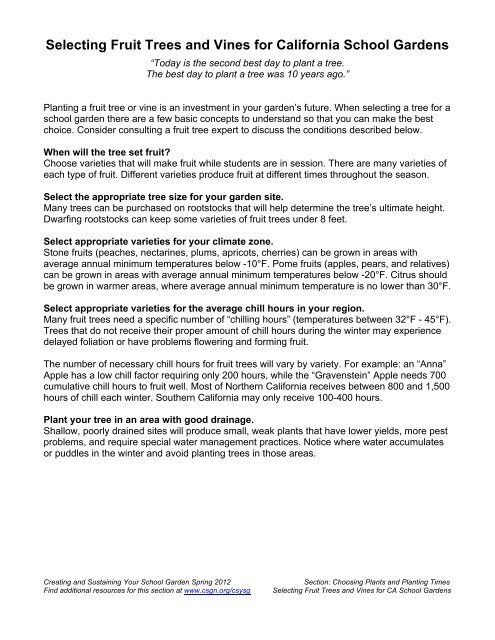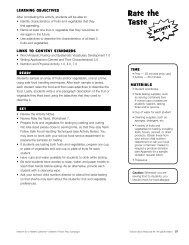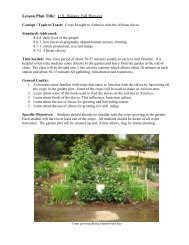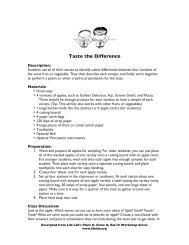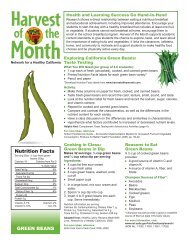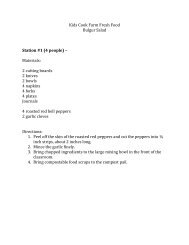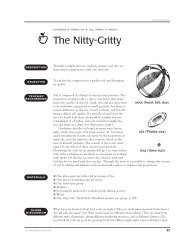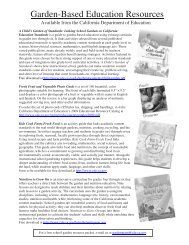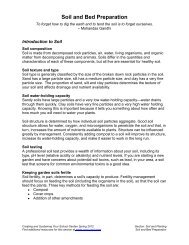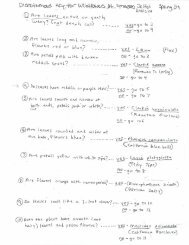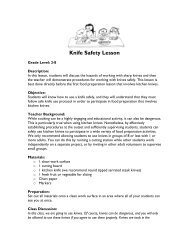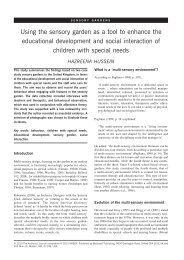Selecting Fruit Trees & Vines for CA School Gardens.pdf - California ...
Selecting Fruit Trees & Vines for CA School Gardens.pdf - California ...
Selecting Fruit Trees & Vines for CA School Gardens.pdf - California ...
You also want an ePaper? Increase the reach of your titles
YUMPU automatically turns print PDFs into web optimized ePapers that Google loves.
<strong>Selecting</strong> <strong>Fruit</strong> <strong>Trees</strong> and <strong>Vines</strong> <strong>for</strong> Cali<strong>for</strong>nia <strong>School</strong> <strong>Gardens</strong><br />
“Today is the second best day to plant a tree.<br />
The best day to plant a tree was 10 years ago.”<br />
Planting a fruit tree or vine is an investment in your garden’s future. When selecting a tree <strong>for</strong> a<br />
school garden there are a few basic concepts to understand so that you can make the best<br />
choice. Consider consulting a fruit tree expert to discuss the conditions described below.<br />
When will the tree set fruit?<br />
Choose varieties that will make fruit while students are in session. There are many varieties of<br />
each type of fruit. Different varieties produce fruit at different times throughout the season.<br />
Select the appropriate tree size <strong>for</strong> your garden site.<br />
Many trees can be purchased on rootstocks that will help determine the tree’s ultimate height.<br />
Dwarfing rootstocks can keep some varieties of fruit trees under 8 feet.<br />
Select appropriate varieties <strong>for</strong> your climate zone.<br />
Stone fruits (peaches, nectarines, plums, apricots, cherries) can be grown in areas with<br />
average annual minimum temperatures below -10°F. Pome fruits (apples, pears, and relatives)<br />
can be grown in areas with average annual minimum temperatures below -20°F. Citrus should<br />
be grown in warmer areas, where average annual minimum temperature is no lower than 30°F.<br />
Select appropriate varieties <strong>for</strong> the average chill hours in your region.<br />
Many fruit trees need a specific number of “chilling hours” (temperatures between 32°F - 45°F).<br />
<strong>Trees</strong> that do not receive their proper amount of chill hours during the winter may experience<br />
delayed foliation or have problems flowering and <strong>for</strong>ming fruit.<br />
The number of necessary chill hours <strong>for</strong> fruit trees will vary by variety. For example: an “Anna”<br />
Apple has a low chill factor requiring only 200 hours, while the “Gravenstein” Apple needs 700<br />
cumulative chill hours to fruit well. Most of Northern Cali<strong>for</strong>nia receives between 800 and 1,500<br />
hours of chill each winter. Southern Cali<strong>for</strong>nia may only receive 100-400 hours.<br />
Plant your tree in an area with good drainage.<br />
Shallow, poorly drained sites will produce small, weak plants that have lower yields, more pest<br />
problems, and require special water management practices. Notice where water accumulates<br />
or puddles in the winter and avoid planting trees in those areas.<br />
Creating and Sustaining Your <strong>School</strong> Garden Spring 2012<br />
Find additional resources <strong>for</strong> this section at www.csgn.org/csysg<br />
Section: Choosing Plants and Planting Times<br />
<strong>Selecting</strong> <strong>Fruit</strong> <strong>Trees</strong> and <strong>Vines</strong> <strong>for</strong> <strong>CA</strong> <strong>School</strong> <strong>Gardens</strong>
<strong>Fruit</strong> <strong>Trees</strong> and <strong>Vines</strong> <strong>for</strong> Cali<strong>for</strong>nia <strong>School</strong> <strong>Gardens</strong><br />
(listed in order of fruiting season)<br />
<strong>Fruit</strong> Name<br />
* These trees require<br />
minimal pruning and<br />
maintenance expertise.<br />
USDA<br />
Zone<br />
Pear 5-8<br />
Apples 5-9<br />
Grapes 4-8<br />
Pineapple Guava * 7-10<br />
Kiwi <strong>Fruit</strong> 8-10<br />
Almond 7-9<br />
Walnut 4-9<br />
Best Time To Plant<br />
Best to plant from bare<br />
root tree in winter<br />
Best to plant from bare<br />
root tree in winter<br />
Best to plant from bare<br />
root tree in winter<br />
Fall<br />
As container plant, can<br />
plant year round<br />
Fall, can plant year round,<br />
need male and female <strong>for</strong><br />
fruit production<br />
Best to plant from bare<br />
root tree in winter<br />
Best to plant from bare<br />
root tree in winter<br />
Harvest Time<br />
Dates may vary<br />
by variety<br />
Summer - Fall<br />
Summer - Fall<br />
Summer - Fall<br />
Tree Height<br />
Tree height varies<br />
by rootstock and<br />
pruning<br />
Dwarf height 8-10 ft,<br />
Standard 30ft<br />
Dwarf height 8-12 ft,<br />
Semidwarf 12-18 ft<br />
Standard 18-22ft<br />
10-15 ft vine,<br />
Grow on trellis or<br />
fence<br />
Evergreen<br />
or<br />
Deciduous<br />
D<br />
D<br />
D Vine<br />
Fall - Winter 4-12 ft E<br />
Fall - Winter<br />
15 -25 ft vine,<br />
Grow on trellis or<br />
fence<br />
D Vine<br />
Fall 12-15 ft D<br />
Fall 20-50 ft D<br />
Pomegranate * 7-11<br />
Best to plant from bare<br />
root tree in winter Fall - Winter 5-12 ft semi - D<br />
Persimmon * 7-10<br />
Citrus * 8-11<br />
Cherries 4-8<br />
Best to plant from bare<br />
root tree in winter<br />
Fall<br />
Container plant, can plant<br />
year round<br />
Best to plant from bare<br />
root tree in winter<br />
Fall - Winter 12-18 ft D<br />
Late Fall - Spring<br />
depending on<br />
variety<br />
6-25 ft ,<br />
depending on<br />
variety<br />
Early Spring 10-30 ft D<br />
E<br />
Apricot or Aprium 4-8<br />
Best to plant from bare<br />
root plant in winter<br />
Late Spring -<br />
Summer<br />
12-20 ft D<br />
Fig * 7-11<br />
Raspberries * 3-9<br />
Fall<br />
Container plant, can plant<br />
year round<br />
Best to plant from bare<br />
root tree in winter<br />
Spring and Fall,<br />
depending on<br />
your region<br />
Late Spring –<br />
Fall, depending<br />
on variety<br />
15-30 ft D<br />
4-6 ft D<br />
Plum or Pluot 4-8<br />
Best to plant from bare<br />
root plant in winter<br />
Late Spring -<br />
Summer<br />
15-40 ft D<br />
Blackberries * 5-8<br />
Best to plant from bare<br />
root plant in winter<br />
Summer - Fall 3-6 ft D<br />
Creating and Sustaining Your <strong>School</strong> Garden Spring 2012<br />
Find additional resources <strong>for</strong> this section at www.csgn.org/csysg<br />
Section: Choosing Plants and Planting Times<br />
<strong>Selecting</strong> <strong>Fruit</strong> <strong>Trees</strong> and <strong>Vines</strong> <strong>for</strong> <strong>CA</strong> <strong>School</strong> <strong>Gardens</strong>


